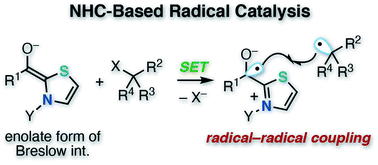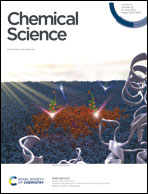Recent advances in N-heterocyclic carbene-based radical catalysis
Abstract
In nature, a number of enzymes use thiamine diphosphate as a coenzyme to catalyze the pyruvate decarboxylation. The resultant enamine, a so-called “Breslow intermediate,” is known to perform single electron transfer to various electron acceptors. Inspired by this enzymatic catalysis, N-heterocyclic carbene (NHC)-catalyzed radical reactions have been developed. This minireview highlights the recent progress and developments in NHC-based radical catalysis. This minireview is categorized according to the reaction types; oxidation type reaction and carbon–carbon bond formation through single electron transfer/radical–radical coupling.

- This article is part of the themed collections: 2021 Nobel Prize in Chemistry – Asymmetric Organocatalysis and Most popular 2019-2020 review articles


 Please wait while we load your content...
Please wait while we load your content...